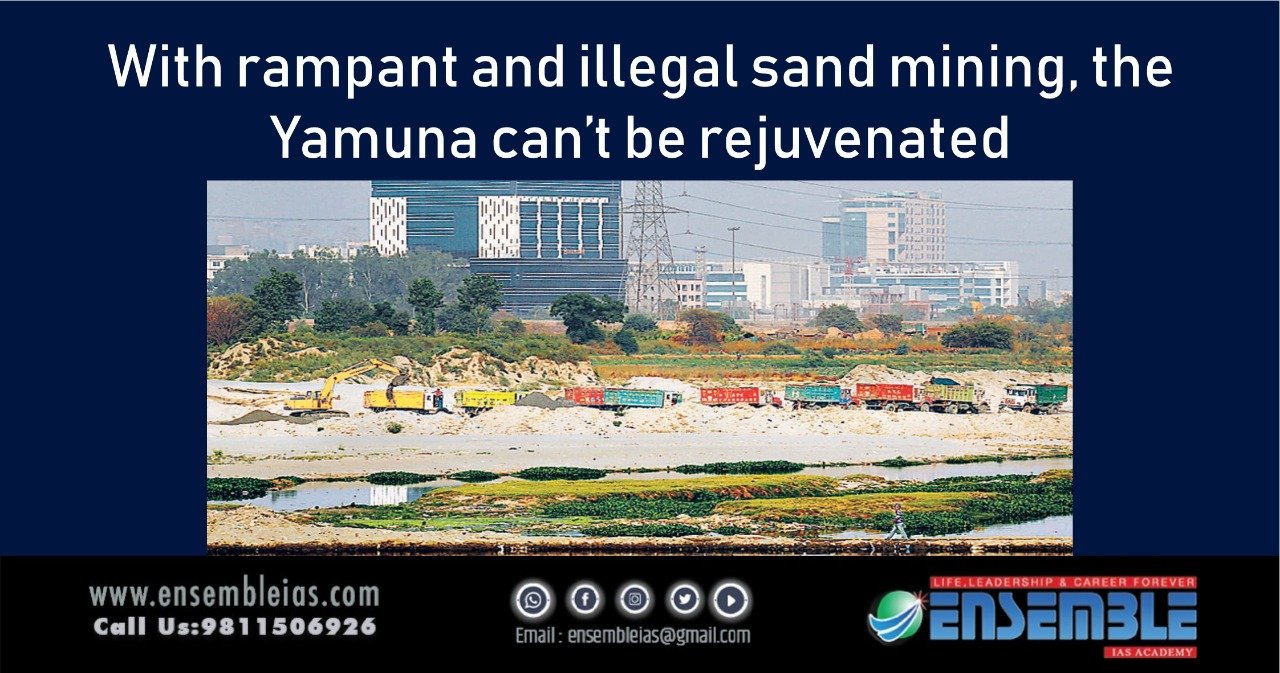With rampant and illegal sand mining, the Yamuna can’t be rejuvenated
With rampant and illegal sand mining, the Yamuna can’t be rejuvenated: While MPD’s plans are bold, the health of the Yamuna, the second largest tributary of the river Ganga, will not improve unless all states take measures to stop industrial pollution, regulate mechanised sand and gravel mining, and agree to revise the interstate water-sharing agreement in 2024
To buy our online courses: Click Here
The draft Master Plan of Delhi (MPD)-2041, released last week for public review, underlines the need to save, restore, and rejuvenate the Capital’s green and blue assets.
Terming the Yamuna and the city’s water bodies “heritage assets”, the draft plan aims to improve the river’s water quality, preserve and improve its fragile ecosystem, and ensure strict manual and technological surveillance to check illegal construction and dumping of sewage in the river and its flood-plains.
The Yamuna crosses several states — Uttarakhand, Haryana, Uttar Pradesh (UP) and Delhi, before re-entering UP again. While MPD’s plans are bold, the health of the Yamuna, the second largest tributary of the river Ganga, will not improve unless all states take measures to stop industrial pollution, regulate mechanised sand and gravel mining, and agree to revise the interstate water-sharing agreement in 2024. Currently, riparian states extract much more from the river than they do for its restoration and rejuvenation.
Illegal sand mining is the elephant in the room. While little of it happens in the 52km National Capital Territory stretch, it is widespread in other riparian states. Yet, there is very little public discussion about the issue since many, mistakenly, view sand as a dispensable resource, and officialdom sees it as a “minor mineral” that generates revenue.
But the impact of such unbridled sand mining on the riverine ecology and lives and livelihoods is immense. It destroys the ecosystem of rivers, changes river courses and affects natural flows and riverbeds, destroys natural habitats of organisms, affects fish breeding and migration, impacts the water table, and increases saline water in the rivers.
Most large rivers worldwide have lost anywhere between half to 95% of their natural sand and gravel delivery to the ocean, says UNEP’S Sand and Sustainability report (2019). In Sand Stories: Surprising Truths about the Global Sand Crisis and the Quest for Sustainable Solutions, Kiran Pereira writes that the world will not achieve global Sustainable Development Goals if it fails to take into account how sand underpins lives and livelihoods, and impacts each of the goals.
Sand is a critical ingredient in our lives. It is the primary raw material to build our cities. It is used in fibre optic cables, glue, cosmetics, glass, silicon chips, and computers – along with virtually every other piece of electronic equipment in one’s home. With such high demand, the world is facing a shortage of sand, which is created by slow geological processes. Desert sand, available in plenty, is not suited for construction use because it is wind-smoothed, and, therefore, non-adherent.
At present, no one even knows exactly how much sand is being pulled out of the earth, where, and under what conditions.
Other than destroying rivers, sand mining has a substantial human cost too. A 2020 report by the South Asia Network on Dams, Rivers and People (SANDRP), a network working on rivers, says that between January 2019 and November 2020, 193 people have died due to illegal river sand mining incidents/accidents in India. In 2018, only 28 deaths were reported. Most deaths related to illegal sand mining are of children who fall into illicit mining sand pits, or due to rash driving by trucks transporting the mined sand. Officials who crack down on the illegal enterprise, and activists and journalists who highlight it, often face the wrath of the sand mining mafia, which usually enjoys support from a section of politicians, police officials, and bureaucrats.
If the Yamuna in Delhi has to have any future, upstream riverine states must regulate sand mining and stop industrial pollution. Experts such as Manoj Misra, a former Indian Forest Service official who is now with Yamuna Jiye Abhiyan, demand that there must be a total ban on mechanised sand mining. This is because machines scoop out more from a riverbed than allowed in mining leases. The building industry has to put its house in order by reusing construction material so that the pressure on resources such as sand is reduced, and must promise to use only legally extracted sand. In fact, India today needs an overarching river law that looks at riverine ecosystems, sand mining and overall basin management.




